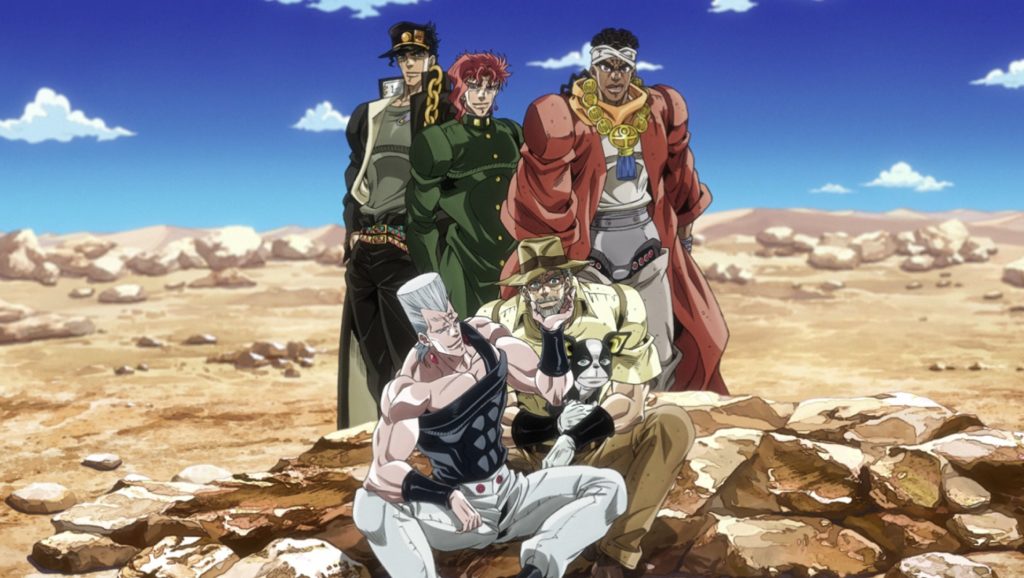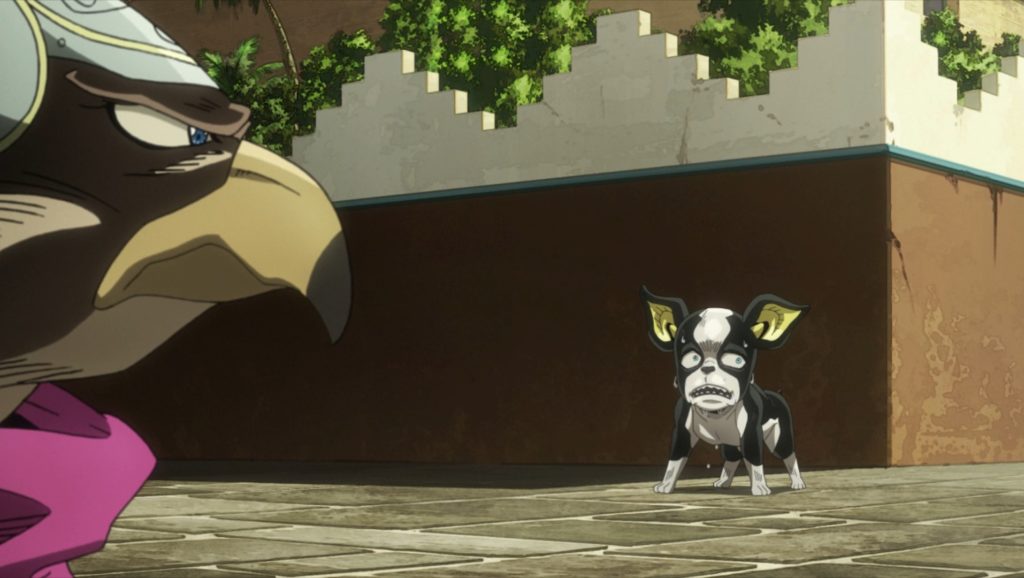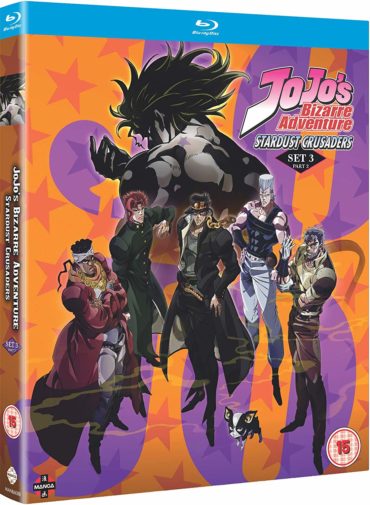JoJo’s Bizarre Adventure Set 3: Stardust Crusaders Part 2 Review
Warning: Contains spoilers to previous collections.
This third set in the JoJo series is a thrilling ride, but before we can go into detail, there is a little scene-setting to be done.
With the first two arcs in Set 1 being located in the 19th century and then 1938, Stardust Crusaders moves the story to 1987. The hero of the second arc, Joseph Joestar, has travelled to Japan where his grandson, Jotaro Kujo is currently in a police cell, refusing to leave. Jotaro believes he is cursed by an evil spirit, but Joseph proves with the help of a friend of his, Mohammed Avdol, that the spirit is called a “Stand”, a manifestation of Jotaro’s own fighting spirit.
Each of these Stands is based on the Tarot. Jotaro’s Stand is called “Star Platinum” and has short range but great strength and speed. Joseph and Avdol also have Stands, the former’s “Hermit Purple” producing vines and making predictions using cameras or TVs to Joseph’s financial cost, the latter’s “Magician’s Red” allowing Avdol to control fire. Jotaro leaves his cell but finds himself attacked by enemies allied to the Joestar family’s greatest foe Dio Brando, now called DIO (in block capitals), who has taken over the body of the late Jonathan Joestar, hero of the first arc. The first enemy Jotaro faces is Noriaki Kakyoin, whose “Hierophant Green” Stand can shoot out blasts of energy. Jotaro defeats him, discovers that Kakyoin is actually being controlled by DIO, and releases him from DIO’s clutches. Kakyoin thus joins their side.
However, Jotaro’s mother and Joseph’s daughter, Holly, falls ill due to an enemy Stand. The only way to cure her is to kill DIO within 50 days, meaning a long-distance journey to Egypt via land and sea as enemy Stands make travelling by plane too dangerous. Along the trip they meet another Stand user controlled by DIO, Jean Pierre Polnareff, whose “Silver Chariot” is a sword-wielding Stand. Again, Jotaro’s gang defeat him, free Polnareff from DIO’s control, and Polnareff joins their side. The rest of the collection sees them continue their journey, defeating other Stand users utterly devoted to DIO’s side.

Moving on to the collection that is actually the subject of this review, Jotaro’s gang have managed to complete the journey to Egypt. Now it is a matter of finding and defeating DIO before it is too late. The first thing to occur is that the gang meet up with members of the Speedwagon Foundation who, as well as providing them with supplies, give them a new ally to work with. Unfortunately this new ally is a bad-tempered and stubborn dog named Iggy. Iggy does however have a Stand, “The Fool”, a shape-shifting being made out of sand. However, soon after they meet, another ally of DIO attacks, but these Stand users in Egypt have powers based on the gods of Ancient Egypt.
As before, Jotaro and his gang have to face even more foes of increasing power as they make their way to Cairo and ultimately locate the mansion in which DIO is hiding, but as well as defeating DIO’s army of devotees, they then have to defeat DIO himself and his Stand, possibly the strongest of all, “The World”.
The main appeal of this collection, as is true with the first half of the series, is the fight sequences. This is partly due to the comparison to the fights that appear in many of most popular shonen series like One Piece or Naruto, the fights in JoJo tend to be condensed into often just a few episodes. Most are one or two episodes long, and the final fight with DIO goes into four, which is shorter than many other shows.
Also, the villains that appear in JoJo are a pretty interesting bunch. This is partly due to the wide variety of abilities the characters are given. Among these are one Stand that makes Joseph and Avdol magnetic, attracting themselves and anything metallic to them; while another villain has a shadow that makes anyone who steps into it dramatically younger, as Polnareff finds out to his cost.

Of the more noteworthy villains, mentions should go to – among others – two people who in the original manga are called Oingo and Boingo, after the American new wave group Oingo Boingo. However, due to copyright laws Viz Media had to change the characters’ names, meaning in this release they are called Zenyatta and Mondatta, after the album Zenyatta Mondatta by The Police (coincidentally, it should be said that there is almost certainly no truth to the idea that the robot monks from the video game Overwatch, Zenyatta and Mondatta, are named after the JoJo characters, and that they too are named after the album). Zenyatta’s Stand allows him to manipulate his face to disguise himself, while Mondatta has a comic book that can predict the future – confusingly, however, the book is called Oingo Boingo and that has not been subject to the same copyright laws as the names of the characters.
While their appearance is brief (although Mondatta returns later in the series), their episode is one of the funniest, and also provides what I consider to be the best of the opening/ending pieces of music in this collection. The opening, “JoJo, That Blood’s Memories ~End of the World~” is performed by artists Hiroaki, Tommy Tominaga, Code and Jin Hashimoto, while the usual ending is “Last Train Home” by the American band the Pat Metheny Group. But the episodes featuring Mondatta end with a more humorous song called “Evil Concerto”, using the grotesque comic style that appears in Mondatta’s comic.
The other positive about the various villains is that as well as providing a varying array of fighting styles, each battle has a different tone to it. One character, for example, is D’Arby, a gambler who spells his name with an apostrophe, and who says in the show that is name is spelt with an apostrophe, but despite this, the subtitles do not at any point show the name spelt with an apostrophe, or indeed in that of his younger brother who appears later in the story. As a gambler, his battles don’t depend on violence and action but drama, as is demonstrated when he and Jotaro play a game of poker where they gamble on their own souls. Elsewhere, there is a greater, more violent confrontation when Iggy the dog ends up battling a falcon with an ice-making Stand who guards DIO’s mansion, in a more animalistic, brutal fight.

The action in JoJo’s Bizarre Adventure in a way feels refreshingly original in comparison to so many other series of its type, and the colourful artwork helps to enhance that even more. What is strange, though, is when you remember that the original manga is in fact older than the other series mentioned earlier in this review. One Piece and Naruto both began in 1997. Stardust Crusaders ended in 1992. By the time One Piece began, JoJo’s fifth arc, Golden Wind, had just ended. Perhaps this is the reason why the various iterations of JoJo’s Bizarre Adventure remain popular to this day.
Regarding problems with this collection, aside from the already-mentioned copyright and subtitling issues, the extras in this collection are few: textless opening, textless closing and trailers. Also, there are some comments in the show that feel dated and sexist, for example when Polnareff complains that Joseph is so late that he is, “taking longer than a woman getting dressed.”
Still, the rest of this collection is deeply entertaining and gripping. Hopefully the next arc, Diamond is Unbreakable, will be getting a UK release too.


